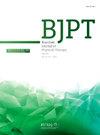Measurement properties of Pain Catastrophizing Scale in individuals with chronic shoulder pain
IF 3.2
3区 医学
Q1 ORTHOPEDICS
引用次数: 0
Abstract
Background
Rotator cuff-related shoulder pain (RCRSP) is a common musculoskeletal disorder. Chronic symptoms, high-level pain intensity, and disability are associated with high levels of pain catastrophizing in this condition. Although the Pain Catastrophizing Scale (PCS) is widely used to assess pain catastrophizing in individuals with chronic symptoms, its measurement properties are still unknown for assessing individuals with chronic RCRSP.
Objectives
To assess construct validity, reliability, and responsiveness of the PCS in individuals with chronic RCRSP.
Methods
Eighty-three adult individuals with chronic RCRSP were included in this study. The assessment of construct validity was based on hypothesis testing. Spearman's rank correlation coefficient was used to verify the correlation of the total score and rumination, magnification, and helplessness subscales of the PCS with pain intensity, disability, and fear of movement. Test-retest reliability was analyzed with Intraclass Correlation Coefficient (ICC)(3,1) and internal consistency was analyzed with Cronbach's alpha. Responsiveness was analyzed by effect sizes and the area under the receiver operating characteristic curve (AUC).
Results
The PCS showed significant moderate correlation (rho ≥ 0.40) with fear of movement (95% confidence interval [CI]: 0.23, 0.70), pain intensity (95% CI: 0.14, 0.64), and disability (95% CI: 0.17, 0.66), except the rumination and magnification subscales, which showed significant weak correlation with pain intensity (95% CI: 0.14, 0.58) and disability (95% CI: 0.12, 0.56), respectively. PCS presented good reliability (ICC > 0.7, 95% CI: 0.63, 0.88), and adequate internal consistency (Cronbach alfa > 0.7) and responsiveness based on effect sizes and AUC.
Conclusion
The PCS is a valid, reliable, and responsive instrument for assessing individuals with chronic RCRSP.
慢性肩痛患者疼痛灾变量表的测量特性
肩袖相关性肩痛(RCRSP)是一种常见的肌肉骨骼疾病。在这种情况下,慢性症状、高强度疼痛和残疾与高水平的疼痛灾难化有关。虽然疼痛灾难化量表(PCS)被广泛用于评估慢性症状个体的疼痛灾难化,但其测量特性在评估慢性RCRSP个体时仍不清楚。目的评价慢性RCRSP患者PCS的结构效度、信度和反应性。方法83例成人慢性RCRSP患者纳入本研究。构念效度评估以假设检验为基础。采用Spearman等级相关系数验证PCS总分、反刍、放大、无助分量表与疼痛强度、残疾、运动恐惧的相关性。用类内相关系数(ICC)(3,1)分析重测信度,用Cronbach’s alpha分析内部一致性。响应性通过效应量和受试者工作特征曲线下面积(AUC)进行分析。结果PCS与运动恐惧(95%可信区间[CI]: 0.23, 0.70)、疼痛强度(95% CI: 0.14, 0.64)和残疾(95% CI: 0.17, 0.66)呈显著的中度相关(rho≥0.40),反刍和放大分量表与疼痛强度(95% CI: 0.14, 0.58)和残疾(95% CI: 0.12, 0.56)呈显著的弱相关。PCS具有良好的可靠性(ICC >;0.7, 95% CI: 0.63, 0.88),以及足够的内部一致性(Cronbach alpha >;0.7)和基于效应大小和AUC的响应性。结论PCS是一种有效、可靠、反应灵敏的慢性RCRSP评估工具。
本文章由计算机程序翻译,如有差异,请以英文原文为准。
求助全文
约1分钟内获得全文
求助全文
来源期刊
CiteScore
6.10
自引率
8.80%
发文量
53
审稿时长
74 days
期刊介绍:
The Brazilian Journal of Physical Therapy (BJPT) is the official publication of the Brazilian Society of Physical Therapy Research and Graduate Studies (ABRAPG-Ft). It publishes original research articles on topics related to the areas of physical therapy and rehabilitation sciences, including clinical, basic or applied studies on the assessment, prevention, and treatment of movement disorders.

 求助内容:
求助内容: 应助结果提醒方式:
应助结果提醒方式:


